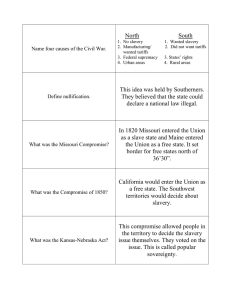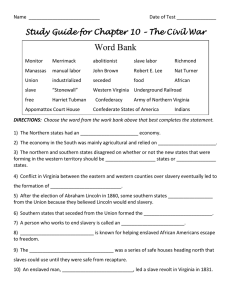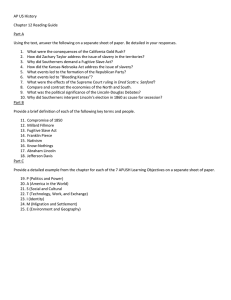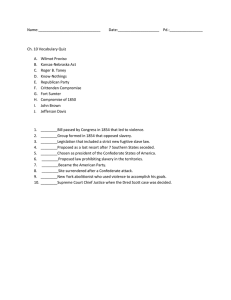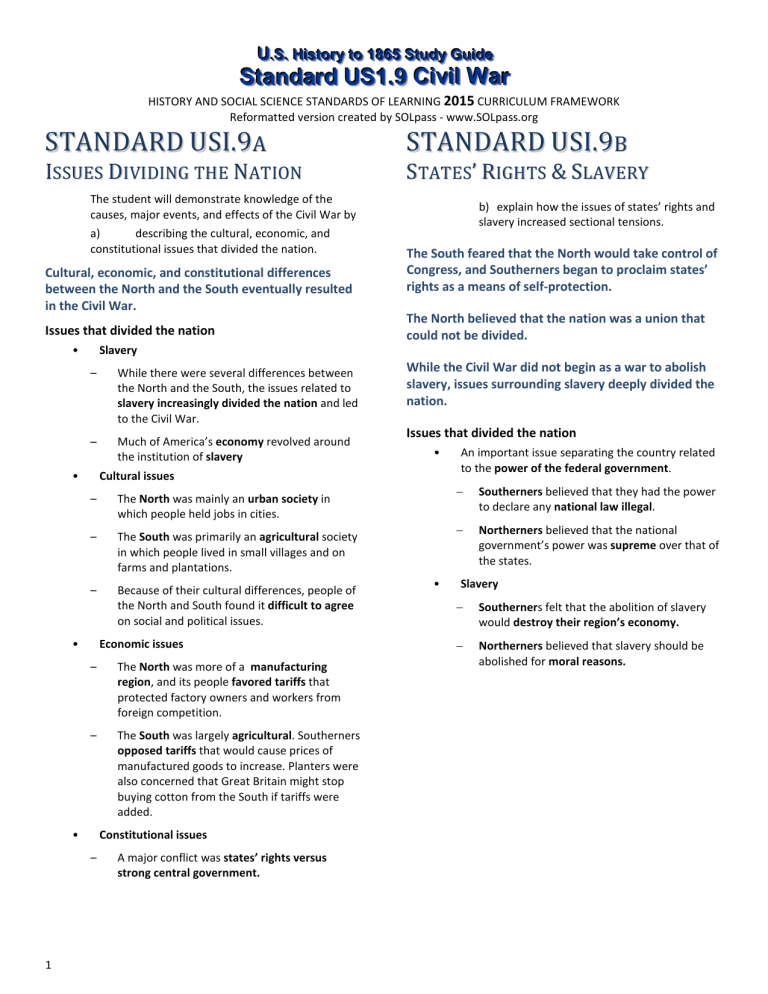
U U..SS.. HHiissttoorryy ttoo 11886655 SSttuuddyy G Guuiiddee S Waarr Ciivviill W S11..99 C US dU daarrd nd Sttaan HISTORY AND SOCIAL SCIENCE STANDARDS OF LEARNING 2015 CURRICULUM FRAMEWORK Reformatted version created by SOLpass - www.SOLpass.org S TA N D A R D U S I. 9 A I S S UE S DIVIDING T HE NAT IO N The student will demonstrate knowledge of the causes, major events, and effects of the Civil War by a) describing the cultural, economic, and constitutional issues that divided the nation. Cultural, economic, and constitutional differences between the North and the South eventually resulted in the Civil War. Issues that divided the nation Slavery • – While there were several differences between the North and the South, the issues related to slavery increasingly divided the nation and led to the Civil War. Much of America’s economy revolved around the institution of slavery ST AT E S’ RIGHT S & SLAVE RY b) explain how the issues of states’ rights and slavery increased sectional tensions. The South feared that the North would take control of Congress, and Southerners began to proclaim states’ rights as a means of self-protection. The North believed that the nation was a union that could not be divided. While the Civil War did not begin as a war to abolish slavery, issues surrounding slavery deeply divided the nation. Issues that divided the nation • Cultural issues • – The North was mainly an urban society in which people held jobs in cities. – The South was primarily an agricultural society in which people lived in small villages and on farms and plantations. – Because of their cultural differences, people of the North and South found it difficult to agree on social and political issues. Economic issues • – The North was more of a manufacturing region, and its people favored tariffs that protected factory owners and workers from foreign competition. – The South was largely agricultural. Southerners opposed tariffs that would cause prices of manufactured goods to increase. Planters were also concerned that Great Britain might stop buying cotton from the South if tariffs were added. Constitutional issues • – 1 S TA N D A R D U S I. 9 B A major conflict was states’ rights versus strong central government. • An important issue separating the country related to the power of the federal government. − Southerners believed that they had the power to declare any national law illegal. − Northerners believed that the national government’s power was supreme over that of the states. Slavery − Southerners felt that the abolition of slavery would destroy their region’s economy. − Northerners believed that slavery should be abolished for moral reasons. Compromises attempting to resolve differences − Missouri Compromise (1820): Missouri entered the Union as a slave state; Maine entered the Union as a free state. − Compromise of l850: − 2 o California entered the Union as a free state. o Southwest territories would decide the slavery issue for themselves. o A stricter fugitive slave law was enacted. o The slave trade was banned in Washington, D.C. Kansas-Nebraska Act: People in each state would decide the slavery issue (“popular sovereignty”) Southern secession • Following Lincoln’s election, the southern states seceded from the Union. • Confederate forces attacked Fort Sumter in South Carolina, marking the beginning of the Civil War. • Lincoln and many Northerners believed that the United States was one nation that could not be separated or divided. Most Southerners believed that the states had freely created and joined the union and could freely leave it. STA ND ARD U S I. 9C ST AT E S T AKE SIDE S c) identify on a map the states that seceded from the Union and those that remained in the Union. Southern states that were dependent upon labor-intensive cash crops seceded from the Union. Northernmost slave states (border states) and free states stayed in the Union. States that seceded from the Union Alabama North Carolina Arkansas South Carolina Florida Tennessee Georgia Texas Louisiana Virginia Mississippi States that remained in the Union Free states Border states (slave states) – California Delaware – New Hampshire Maryland – Connecticut Kentucky – New Jersey Missouri – Illinois – New York – Indiana – Ohio – Iowa – Oregon – Kansas – Pennsylvania – Maine – Rhode Island – Massachusetts – Vermont – Michigan – West Virginia* – Minnesota – Wisconsin *Note: Western counties of Virginia that refused to secede from the Union 3 S TA N D A R D U S I. 9D CIVIL WAR L E AD E RS d) describe the roles of Abraham Lincoln, Jefferson Davis, Ulysses S. Grant, Robert E. Lee, Thomas “Stonewall” Jackson, and Frederick Douglass in events leading to and during the war. Lincoln and Lee were men who represented views of the nature of the United States that were very different; such views led to an unavoidable conflict. Roles of Civil War leaders − Abraham Lincoln Was president of the United States Opposed the spread of slavery Issued the Emancipation Proclamation Was determined to preserve the Union, by force if necessary Believed the United States was one nation, not a collection of independent states Wrote the Gettysburg Address that said the Civil War was to preserve a government “of the people, by the people, and for the people” − Jefferson Davis Was president of the Confederate States of America − Ulysses S. Grant Was general of the Union army that defeated Lee − Robert E. Lee Was leader of the Army of Northern Virginia Was offered command of the Union forces at the beginning of the war, but chose not to fight against Virginia Opposed secession, but did not believe the Union should be held together by force Urged Southerners to accept defeat at the end of the war and reunite as Americans when some wanted to fight on − Thomas “Stonewall” Jackson Was a skilled Confederate general from Virginia − Frederick Douglass Was a former enslaved African American who promoted African American involvement in the Civil War 4 S TA N D A R D U S I. 9 E MAJOR B AT T LE S e) use maps to explain critical developments in the war, including major battles. Location and topography were critical elements influencing important developments in the Civil War, including major battles. Major battles and events • The firing on Fort Sumter, S.C., began the war. • The first Battle of Manassas (Bull Run) (also known as the Battle of First Manassas) in northern Virginia was the first major battle. • The signing of the Emancipation Proclamation made “freeing the slaves” the new focus of the war. − Many freed African Americans joined the Union army. • The Battle of Vicksburg in southern Mississippi divided the South; the North controlled the Mississippi River. • The Battle of Gettysburg in southern Pennsylvania was the turning point of the war; the North repelled Lee’s invasion. • Lee’s surrender to Grant at Appomattox Court House in 1865 ended the war. Influence of location and topography on critical developments in the war 5 • The Union blockade of southern ports (e.g., Savannah, Charleston, New Orleans) • Control of the Mississippi River (e.g., Vicksburg) • Battle locations influenced by the struggle to capture capital cities (e.g., Richmond; Washington, D.C.) • Control of the high ground (e.g., Gettysburg) S TA N D A R D U S I. 9F EFFE CT S OF WAR f) describe the effects of war from the perspectives of Union and Confederate soldiers (including African American soldiers), women, and enslaved African Americans. Life on the battlefield and on the home front was extremely harsh. Many soldiers died from disease and exposure. − • Women were left to run businesses in the North and farms and plantations in the South. • The collapse of the Confederacy made Confederate money worthless. Effects of the war on African Americans • African Americans fought in the Union army. Some African Americans accompanied Confederate units in the field. General effects of the war 6 Combat was brutal and often man-to-man. • Family members were often pitted against one another, as were friends against friends. • As the war went on, Southern troops became increasingly younger and more poorly equipped and clothed. • • Much of the South was devastated at the end of the war (e.g., burning of Atlanta and Richmond). The Confederacy used enslaved African Americans as ship workers, laborers, cooks, and camp workers. • The Union moved to enlist African American sailors during the war. • African American soldiers were paid less than white soldiers. • Disease was a major killer. • • Clara Barton, a Civil War nurse, created the American Red Cross. African American soldiers were discriminated against and served in segregated units under the command of white officers. • Robert Smalls, an African American sailor and later a Union naval captain, was highly honored for his feats of bravery and heroism. He was elected to the United States House of Representatives after the war.

